1994 CADILLAC FLEETWOOD brakes
[x] Cancel search: brakesPage 201 of 398
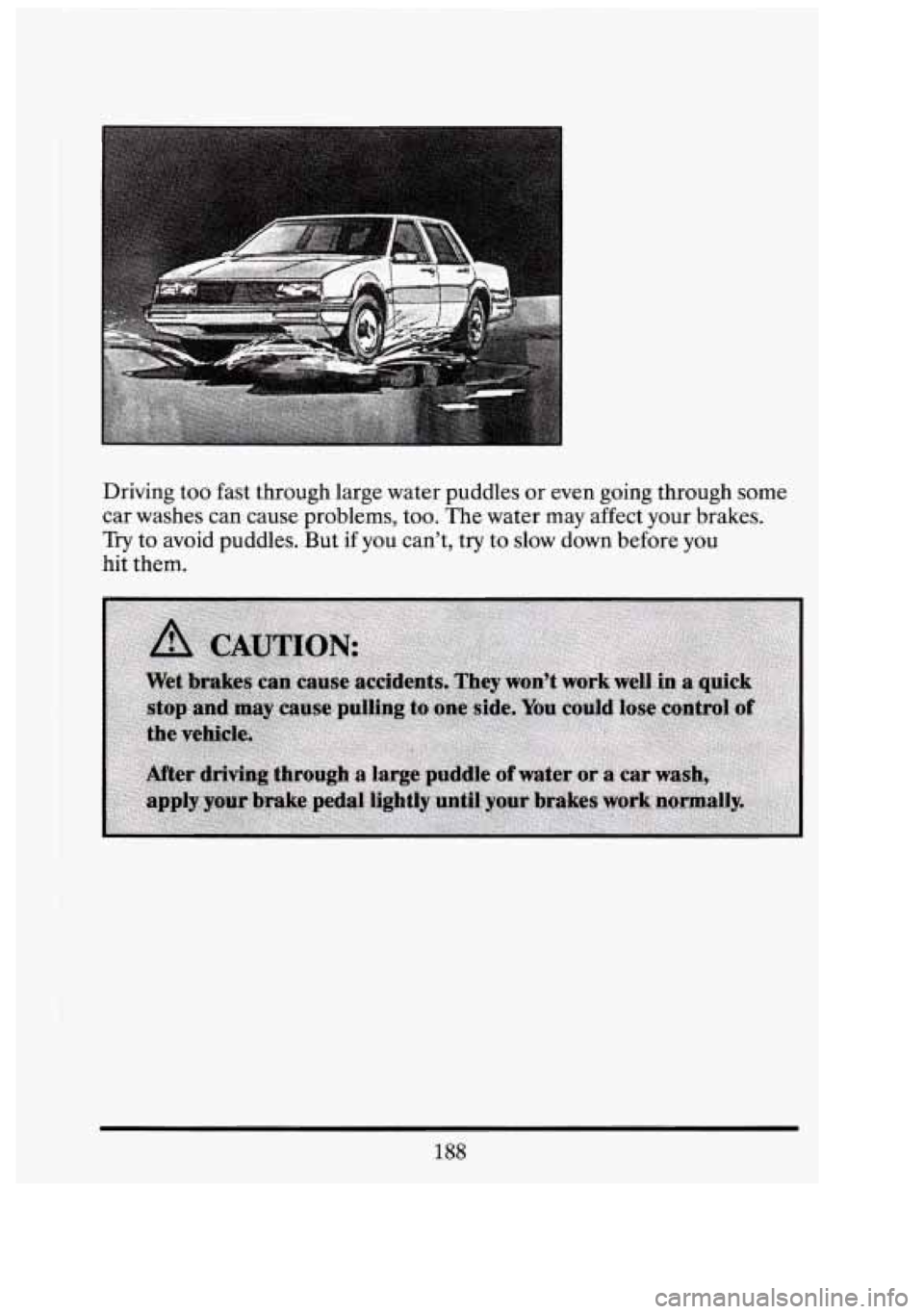
t
Driving too fast through large water puddles or even going through some
car washes can cause problems, too. The water may affect your brakes.
Try to avoid puddles. But
if you can't, try to slow down before you
hit them.
188
P
UI
a '1
Page 207 of 398
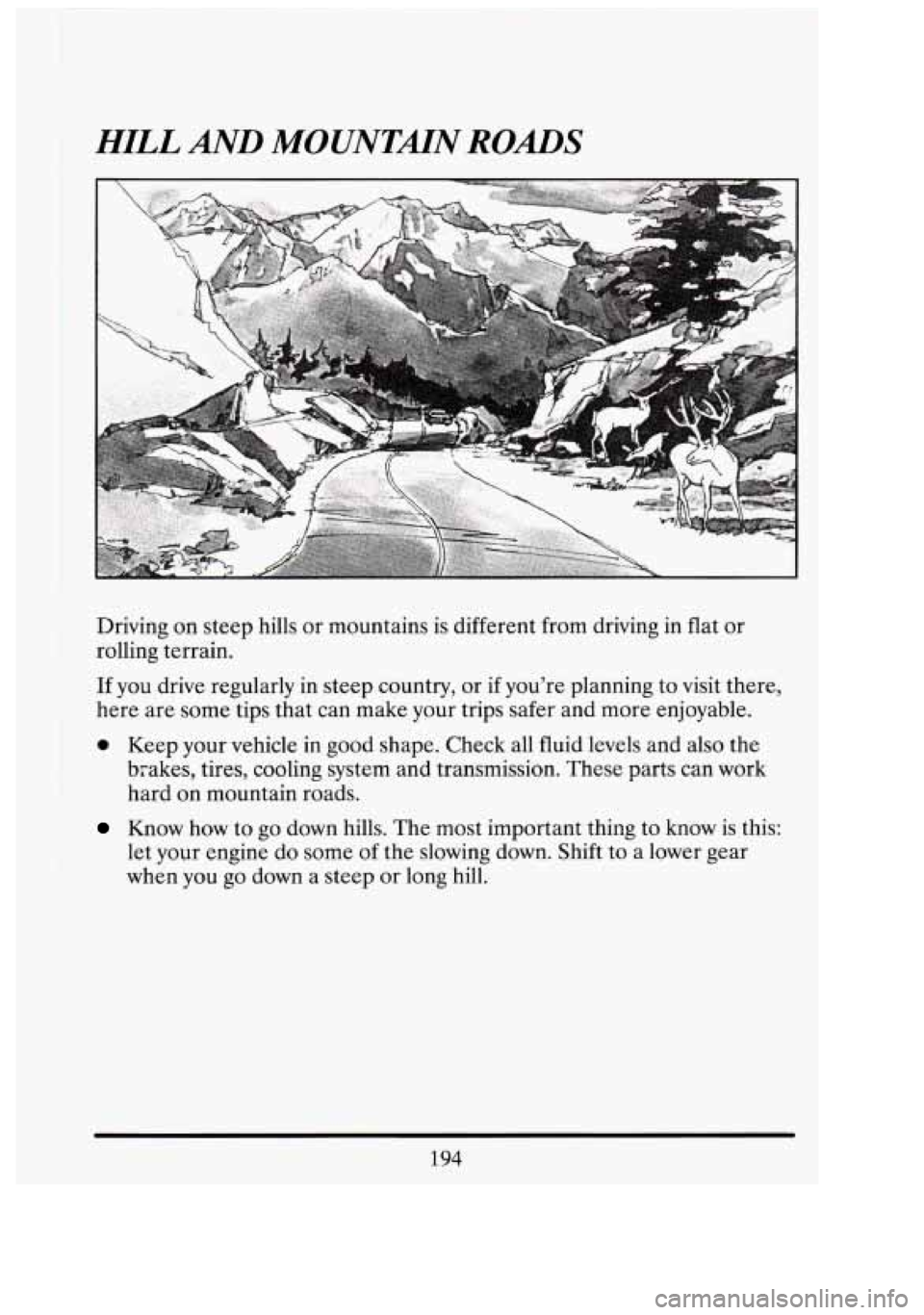
HILL AND MOUNTMN ROADS
Driving on steep hills or mountains is different from driving in flat or
rolling terrain.
If you drive regularly in steep country, or if you’re planning to visit there,
here are some tips that can make your trips safer and more enjoyable.
0 Keep your vehicle in good shape. Check all fluid levels and also the
brakes, tires, cooling system and transmission. These parts can work
hard on mountain roads.
Know how to go down hills. The most important thing to know is this:
let your engine do some
of the slowing down. Shift to a lower gear
when you go down a steep or long hill.
194
13
I
Page 211 of 398
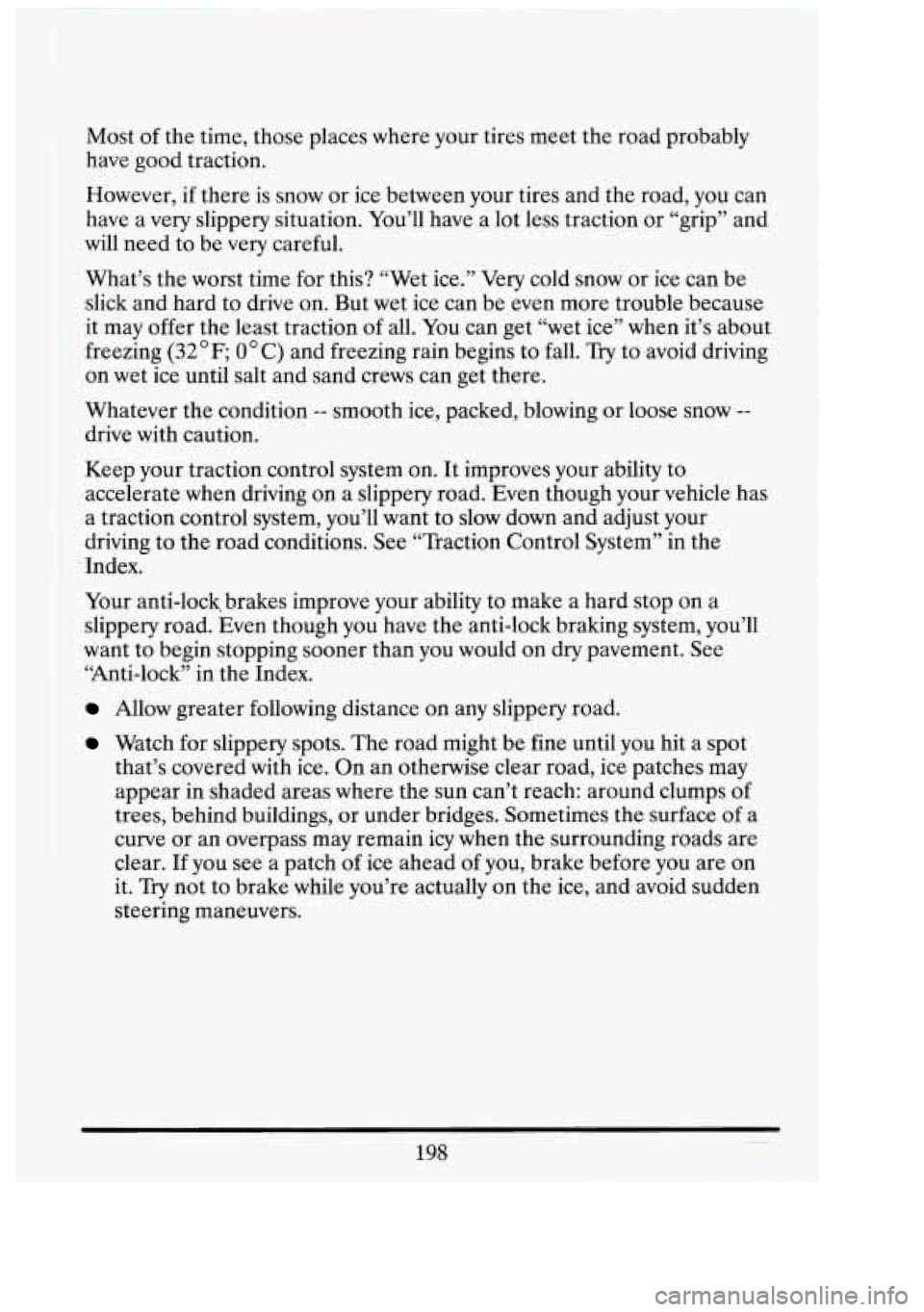
Most of the time, those places where your tires meet the road probably
have good traction.
However, if there is snow or ice between your tires and the road,
you can
have a
very slippery situation. You’ll have a lot less traction or “grip” and
will need to be very careful.
What’s the worst time for this? “Wet ice.”’Very cold snow or ice can be
slick and .hard to drive
on. But wet ice can be even more trouble because
it may offer the least traction of all. You can get “wet ice”
when it’s about
freezing
(32 OF; 0 * C) and freezing rain begins to fall. Try to .avoid driving
on wet ice until salt and sand crews can get there.
Whatever the condition
-- smooth ice, packed, blowing or loose snow --
drive with caution.
1 Keep your traction control system on. It improves your ability to
accelerate when driving on a slippery road. Even though your vehicle has
a traction control system, you’ll want to slow down and adjust your
driving to the road conditions. See “Traction Control System’’ in the
Index.
l
Your anti-lock, brakes improve your ability to make a hard stop on a
slippery road. Even though you have the anti-lock braking system, you’ll
.want to begin stopping sooner than you would on dry pavement. See
“Anti-lock”
in the Index.
Allow greater following distance on any slippery road.
Watch for slippery spots. The road might be fine until you hit a spot
that’s covered with ice.. On an otherwise clear road, ice patches may
appear in shaded areas where the sun can’t reach: around clumps
of
trees, behind buildings, or under bridges. Sometimes the surface of a
curve or an overpass may remain icy when the surrounding roads are
clear.
If you see a patch of ice ahead of you; brake before you are on
it. Try not to brake while you’re actually on the ice, and avoid sudden
steering maneuvers.
E
l
I
El
I
I
-1
i
198
Page 215 of 398
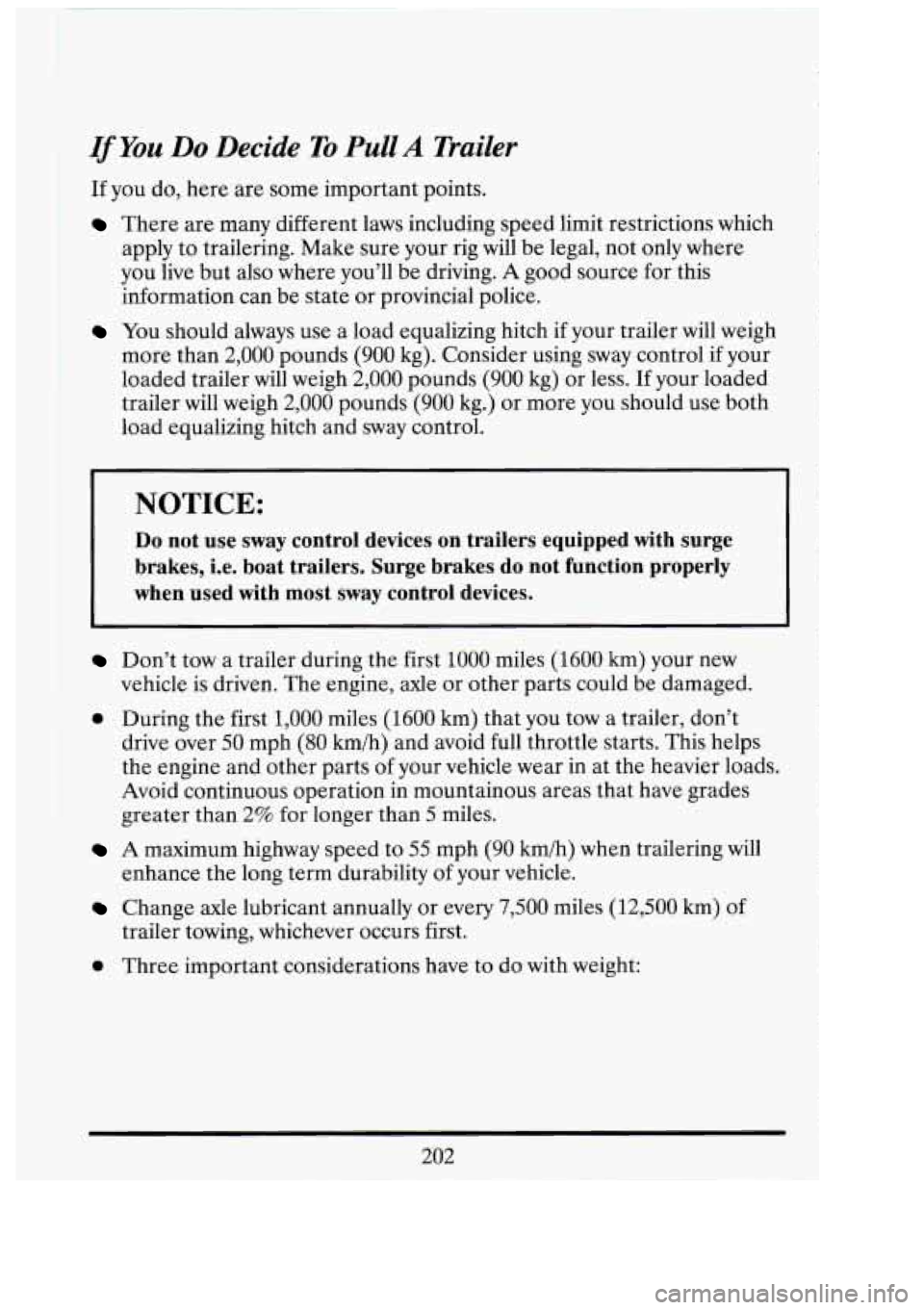
I
If You Do Decide To Pull A Trailer
If you do, here are some important points.
There are many different laws including speed limit restrictions which
apply to trailering. Make sure your rig
will be legal, not only where
you live but also where you’ll be driving.
A good source for this
information can be state or provincial police.
You should always use a load equalizing hitch if your trailer will weigh
more than
2,000 pounds (900 kg). Consider using sway control if your
loaded trailer will weigh
2,000 pounds (900 kg) or less. If your loaded
trailer will weigh
2,000 pounds (900 kg.) or more you should use both
load equalizing hitch and sway control.
NOTICE:
Do not use sway control devices on trailers equipped with surge
brakes, i.e. boat trailers. Surge brakes
do not function properly
when used with most sway control devices.
Don’t tow a trailer during the first 1000 miles (1600 km) your new
vehicle is driven. The engine, axle or other parts could be damaged.
5 During the first 1,000 miles (1600 km) that you tow a trailer, don’t
drive over
50 mph (80 km/h) and avoid full throttle starts. This helps
the engine and other parts
of your vehicle wear in at the heavier loads.
Avoid continuous operation in mountainous areas that have grades
greater than
2% for longer than 5 miles.
A maximum highway speed to 55 mph (90 km/h) when trailering will
enhance the long term durability of your vehicle.
Change axle lubricant annually or every 7,500 miles (12,500 km) of
trailer towing, whichever occurs first.
0 Three important considerations have to do with weight:
202
o/
I
I
c
nl
I
‘p’
u,
Page 218 of 398

r Hitches
It’s important to have the correct hitch equipment. Crosswinds, large
trucks going by, and rough roads are a few reasons
why you need the right
hitch. Here are some rules to follow:
If you pull a fully loaded trailer that will weigh more than 2,000
pounds
(900 kg), be sure to use a properly mounted,
weight-distributing hitch and sway control of the proper size. This
equipment is very important for proper vehicle loading and good
handling when you’re driving.
Will you have to make any holes in the body of your vehicle when you
install a trailer hitch?
If you do, be sure to seal the holes to prevent
deadly carbon monoxide (CO) from your exhaust from entering into
your vehicle (see Index under “Carbon Monoxide”).
Don’t let the steel in a hitch contact the aluminum on your bumper. If
you do, the
two will corrode. You can use a insulator such as paint or
plastic tape to separate the steel and aluminum. The same steel to
aluminum corrosion can happen with fasteners, too.
Using A Dead Weight Trailer Hitch
The trailer tongue should weigh 10% of the total trailer load
(maximum 300
lbs.) or as specified by the trailer manufacturer to
minimize sway.
Trailer brakes of adequate size are required on trailers over 1,000 lbs.
(450 kg) loaded weight.
0 If the trailer is over 5,000 lbs. (2270 kg) adjust vehicle rear tire
pressure to (35 psi cold tire pressure).
7
NOTICE:
Surge brakes do not function properly if used with most
equalizer hitches.
Page 220 of 398
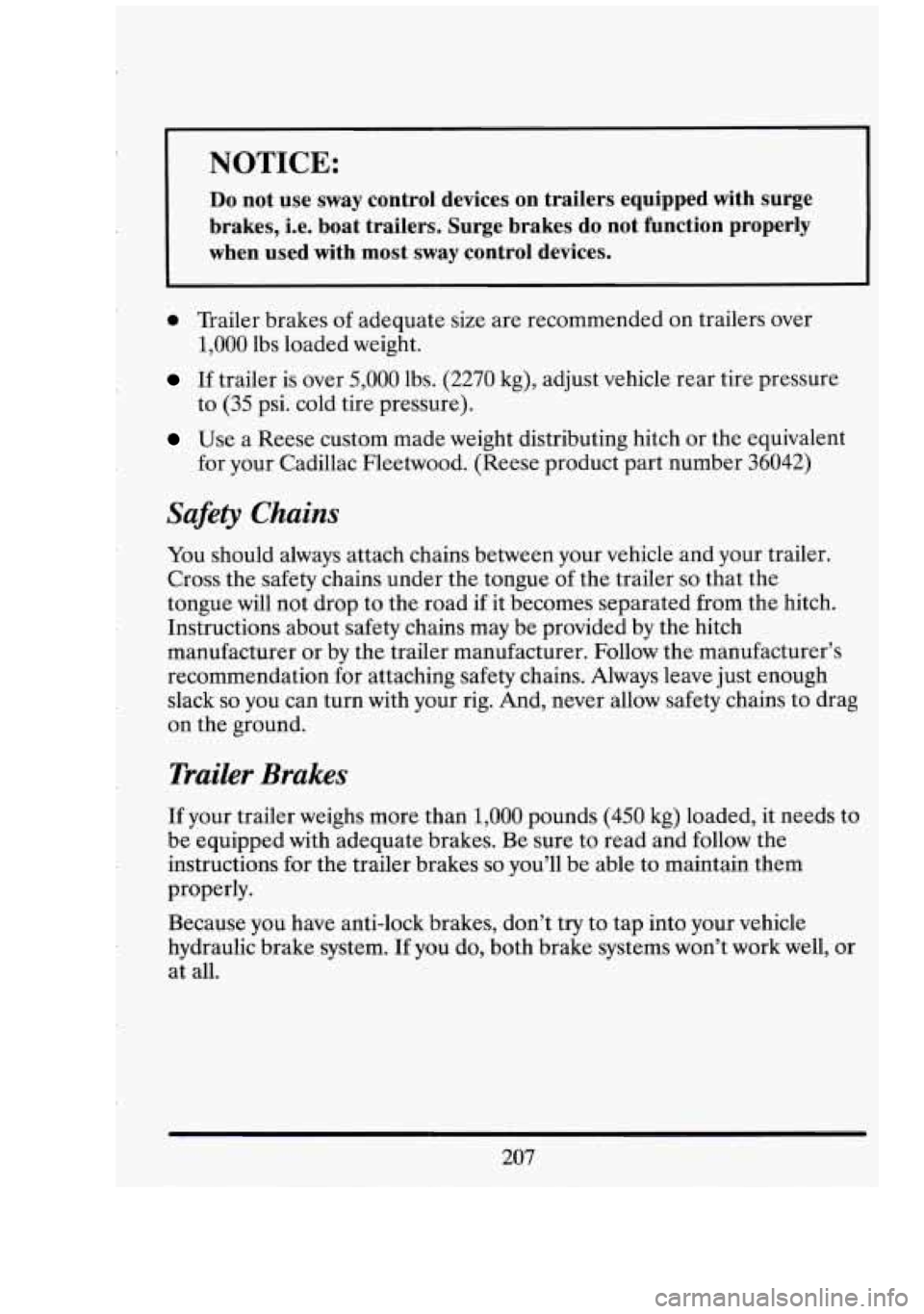
r
NOTICE:
Do not use sway control devices on trailers equipped with surge
brakes, i.e. boat trailers. Surge brakes do not function proper\
ly
when used with most sway control devices.
0 Trailer brakes of adequate size are recommended on trailers over
1,000 lbs loaded weight.
If trailer is over 5,000 lbs. (2270 kg), adjust vehicle rear tire pressure
to (35 psi. cold tire pressure).
Use a Reese custom made weight distributing hitch or the equivalent
for your Cadillac Fleetwood. (Reese product part number 36042)
Safety Chains
You should always attach chains between your vehicle and your trailer.
Cross the safety chains under the. tongue of the trailer
so that the
tongue will not drop to the road
if it becomes separated from the hitch.
Instructions about safety chains may be provided by the hitch
manufacturer or by the trailer manufacturer. Follow the manufacturer’s
recommendation for attaching safety chains. Always leave just enough
slack
so you can turn with your rig. And, never allow safety chains to drag
on the ground.
Trailer Brakes
If your trailer weighs more than 1,000 pounds (450 kg) loaded, it needs to
be equipped with adequate brakes. Be sure to read and follow the
instructions for the trailer brakes
so you’ll be able to maintain them
properly.
Because you have anti-lock brakes, don’t try to tap into your vehicle
hydraulic brake system. If you do, both brake systems won’t work well, or
at all.
207
Page 221 of 398
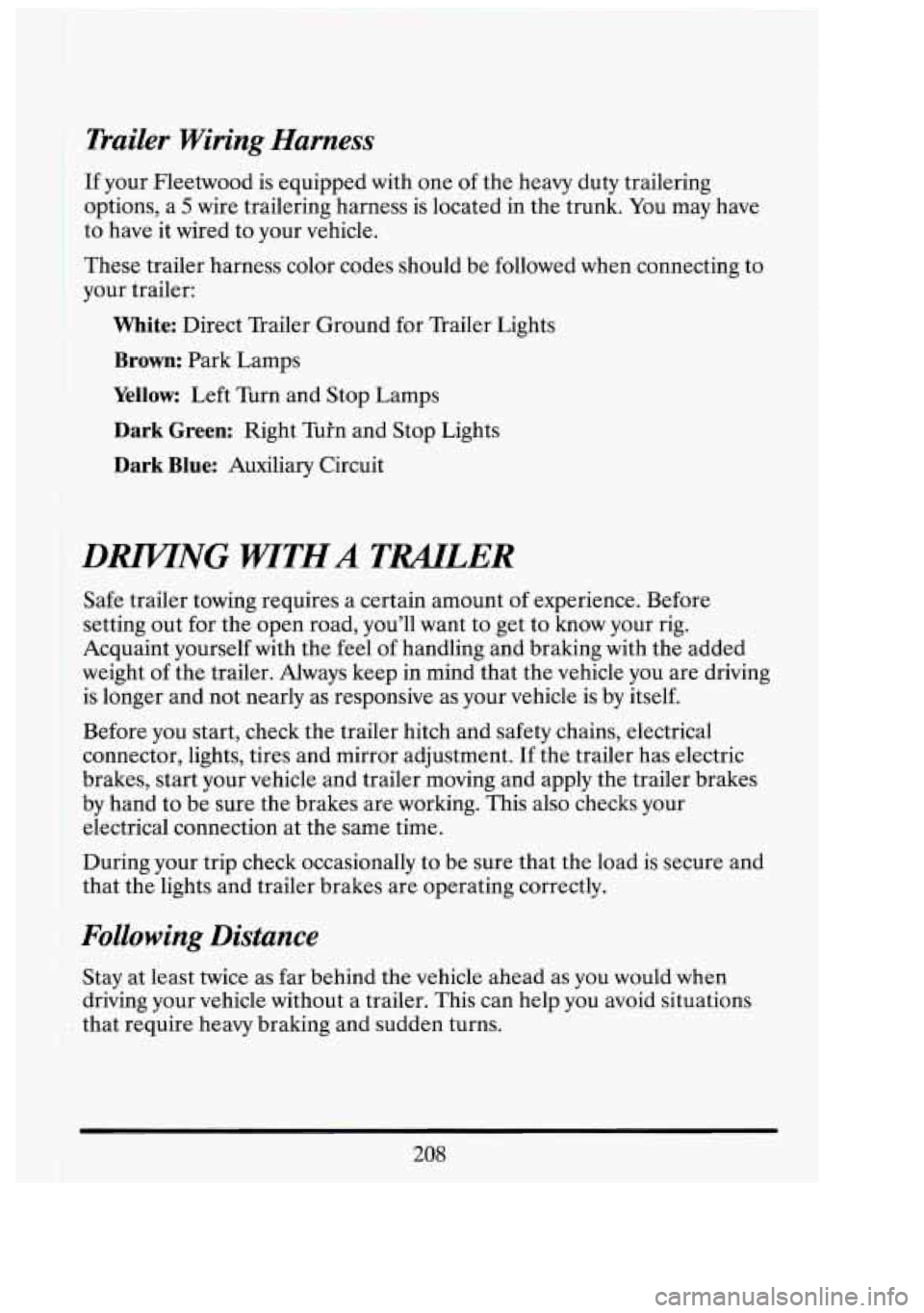
I
Trailer Wiring Harness
I
If your Fleetwood is equipped with one of the heavy duty trailering
options, a
5 wire trailering harness is located in the trunk. You may have
to have it wired to your vehicle.
These trailer harness color codes should be followed when connecting to
your trailer:
White: Direct Trailer Ground for Trailer Lights
Brown: Park Lamps
Yellow: Left Turn and Stop Lamps
Dark Green: Right Tuh and Stop Lights
Dark Blue: Auxiliary Circuit
DRIFTNG WTHA TWLER
Safe trailer towing requires a certain amount of experience. Before
setting out
for the open road, you'll want to get to know your rig.
Acquaint-yourself with the feel
of handling and braking with the added
weight of the trailer. Always keep in mind that the vehicle you are driving
is longer and not nearly as responsive as your vehicle is by itself.
Before you start, check the trailer hitch and safety chains, electrical
connector, lights, tires and mirror adjustment.
If the trailer has electric
brakes, start your vehicle and trailer moving and apply the trailer brakes
by hand to be sure the brakes are working. This also checks your
electrical connection at the same time.
During your trip check occasionally to be sure that the load is secure and
that the lights and trailer brakes are operating correctly.
Following Distance
Stay at least twice as far behind the vehicle ahead as you would when
driving your vehicle without a trailer. This can help you avoid situations
that require heavy braking and sudden turns.
208
I
I
Page 222 of 398
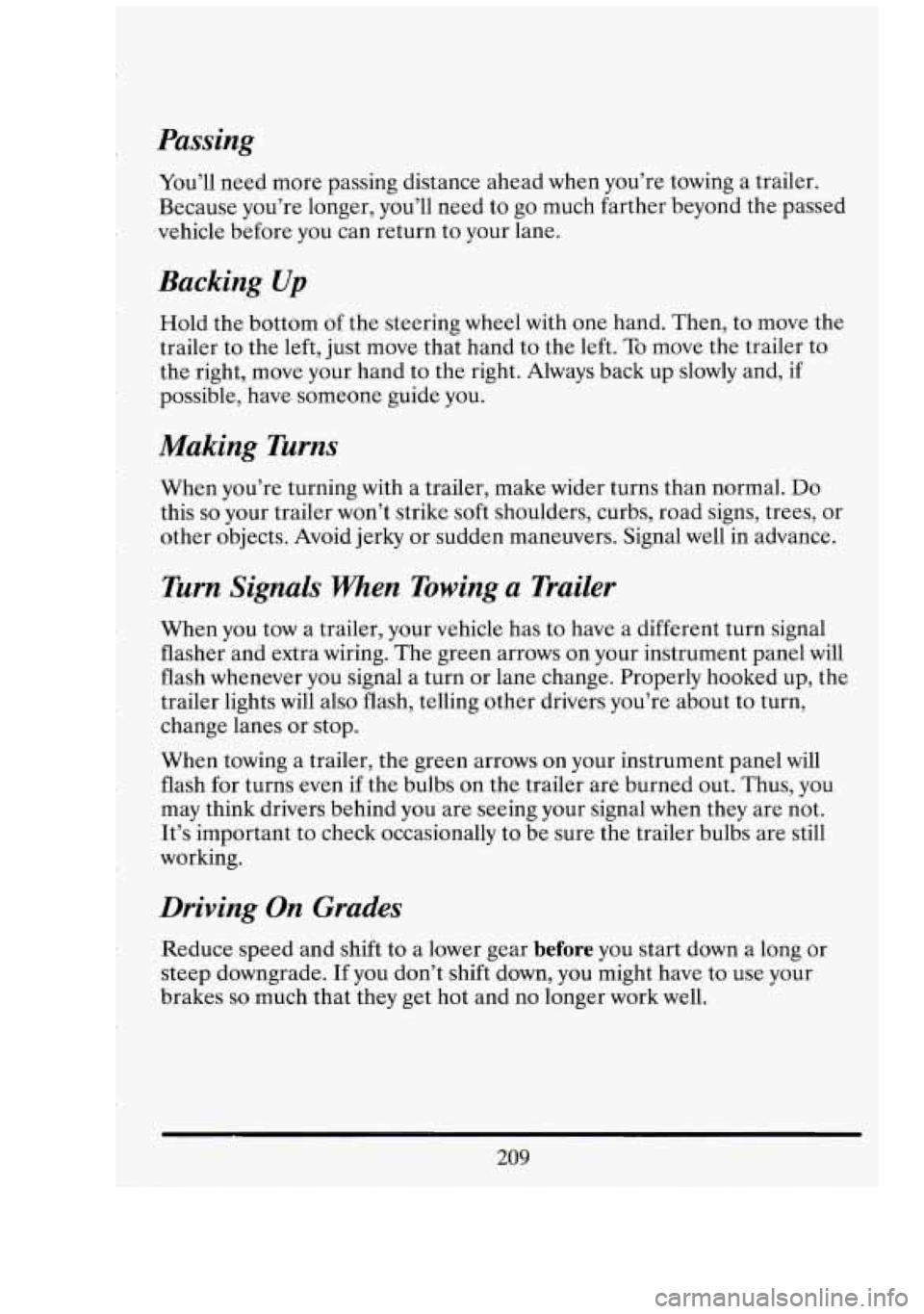
Passing
You’ll need more passing distance ahead when you’re towing a trailer.
Because you’re longer, you’ll need to go much farther beyond the passed
vehicle before you can return to your lane.
Backing Up
Hold the bottom of the steering wheel with one hand. Then, to move the
trailer to the left, just move that hand to the left.
To move the trailer to
the right, move your hand to the right. Always back up slowly and, if
possible, have someone guide you.
Making Turns
When you’re turning with a trailer, make wider turns than normal. Do
this so your trailer won’t strike soft shoulders, curbs, road signs, trees, or
other objects. Avoid jerky or sudden maneuvers. Signal well in advance.
Turn Signals When Towing a Trailer
When you tow a trailer, your vehicle has to have a different turn signal
flasher and extra wiring. The green arrows on your instrument panel will
flash whenever you signal a turn or lane change. Properly hooked up, the
trailer lights will also flash, telling other drivers you’re about to turn,
change lanes or stop.
When towing a trailer, the green arrows on your instrument panel will
flash for turns even if the bulbs on the trailer are burned out. Thus, you
may think drivers behind you are seeing your signal when they are not.
It’s important to check occasionally to be sure the trailer bulbs are still
working.
Driving On Grades
Reduce speed and shift to a lower gear before you start down a long or
steep downgrade.
If you don’t shift down, you might have to use your
brakes
so much that they get hot and no longer work well.
209